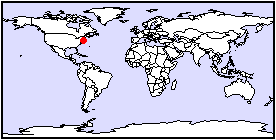Town/City:
|
Mineola
|
State/Province:
|
New York
|
Country:
|
United States
|
Latitude/Longitude:
|
39.6N 72.42W
|
Information supplied by
G. R. Stanley
55 Chevron Crescent, Scarborough, Ontario, M1K 3N6
Dated Wed Nov 24 10:10:45 1999 |
Information Topics:
City Description:
The Town of Mineola is situated on west Long Island and is the county seat
or capital for Nassau County, New York. Nassau County's western neighbours
on Long Island are Kings County (or Brooklyn) and Queens County, both boroughs
of New York City. Nassau County's eastern neighbour is Suffolk County.
Combined together these counties have an area of 1,723 square miles (4,463
km2) and a population (1990 census) of 6,861,474 (Compton's
Interactive Encyclopedia, 1994, 1995). In the early 1800s, Mineola was
a region of farms, forests and pastures. The construction of rail lines
in the 1830s facilitated the region's connection to New York City and led
to its settlement. By the mid-20th century a network of highways and bridges
delivered a flow of traffic which stimulated and enhanced Mineola's growth
as a center for shipping and commerce. This is exemplified by being just
north of Garden City (pop. 21,686); 5 miles (9 km) north of Hempstead (pop.
49,453); 6 miles (10 km) west of Levittown (pop. 53,286); 10 miles (16
km) northwest of Massapequa Park (pop. 18,044); and 7 miles (11 km) southwest
of Westburg (pop. 13,060) [Compton's Interactive Encyclopedia, 1994, 1995].
Today Mineola is home to over 19,000 residents, acting as a railway junction
and trade center for many of Nassau County's towns and villages. Mineola
and its surrounding districts can presently be categorized into five basic
land uses: (1) Suburban land sewered more than 22 years (long-term sewered),
(2) Suburban land recently sewered (less than 8 years), (3) Suburban land
without a regional sewer system, (4) Agricultural land and (5) Undeveloped
land (Buxton and Modica, 1992). Mineola by itself resembles much of central
Long Island with office plazas, light industries and shopping centers amidst
medium to highly dense suburban areas (Ku et al., 1992).
Back to Topics
Climate:
On average, the Town of Mineola's climate is comparable to that of Long
Island. The growing season (mid-May through to mid-October) and dormant
season (Mid-October through to mid-May) have temperature ranges that usually
are moderated by Long Island's ambient water bodies (Long Island Sound
to the north and the Atlantic Ocean to the south). Mineola experiences
approximately 110 sunny days, 139 partly sunny days and 116 cloudy days
each year. These climate variables help yield an average annual temperature
of 53 degrees F (12 C), average annual precipitation levels of 45 inches
(1143 mm), an average annual snowfall of 27 inches (686 mm) and an average
humidity of 68% [http://www.co.nassau.ny.us/demograp.html].
Losses from the water balance which affect local climate are in the form
of annual average evapotranspiration and recharge to snow and rainfall,
which are estimated to be 21.5 inches (546 mm) and 22.5 inches (572 mm),
respectively (Ku et al., 1992). When these modern variables are compared
to preurban levels, only recharge has experienced the greatest change.
Back to Topics
Basic Hydrogeology:
The groundwater system of Mineola can be considered as a component of a
much larger, island wide system. This system's development has been attributed
to a series of geological events, with the first involving the formation
of a crystalline bedrock layer, which is estimated to average a depth of
204 m below the land surface (McNew and Arav, 1995). The bedrock is overlain
by a continuous layer of rock formed from shallow sea-floor sediments of
mud, lime and sand about 600 million years ago. These later became rock
upon being modified by heat and pressure during episodes of mountain building
(http://www.journey.sunysb.edu/longis/geover.html).
The subsequent facies or sediment groups are Cretaceous materials that
were deposited in a large river delta about 80 million years ago, and 20,000
year old Pleistocene glacial deposits (usually called till) consisting
of clay, silt, sand and gravel. It is believed that the impetus which generated
these layers is what eventually formed Long Island in the last Ice Age
when ice advancements of a glacier that covered New England eventually
formed a moraine in the ocean to rest on a underwater ridge of rock (http://www.journey.sunysb.edu/longis/glacial.html).
This process also established a groundwater regime where the movement of
groundwater is generally towards both the northern and southern shores.
The hydrogeology beneath Mineola consists of three main aquifers and two
confining units (Eckhardt and Stackelberg, 1995). Of the Pleistocene deposits,
the major units are the Gardiners Clay (confining unit), an interglacial
marine clay, and the upper glacial (water-table) aquifer of Wisconsin age.
The upper glacial aquifer consists of glacial till and outwash deposited
during the Pleistocene ice advances. The largest of the aquifers, known
as the Magothy, lies beneath the upper glacial aquifer. The Magothy aquifer
is of Cretaceous age (80 million years) and characterized by a distinctive
basal gravel zone approximately 100 feet thick. The Raritan Clay underlies
the Magothy, and as a confining layer restricts movement of water into
what is known as the Lloyd Aquifer, which lies in contact with the bedrock.
Much of the water that enters the flow system below Mineola moves laterally
through the upper glacial aquifer and discharges to streams. Locally the
water table is primarily in the glacial aquifer and is shaped by shallow
flow subsystems, which discharge to streams or downward into the deeper
confined aquifers. Buxton and Modica (1992) quantified that sixty two percent
of the water flows no deeper than the upper glacial (water table) aquifer,
38 percent enters the underlying Magothy aquifer, and only 3.1 percent
enters the Lloyd aquifer. In these deeper aquifers, groundwater moves laterally
towards the shoreline, where it returns to the upper glacial aquifer and
discharges at the shore or continues offshore. Near shore the water mixes
with saline ground water as it passes through the overlying confining unit
and is lost from the system (Buxton and Modica, 1992; McNew and Arav, 1995).
Back to Topics
Water Use:
It should be noted that all regions of Long Island except Brooklyn and
Queens depend solely on groundwater extraction from private and public
wells for freshwater supply. In the case of Mineola, the use of groundwater
can be itemized in terms of its infrastructure. For commercial offices,
industry, market retail, residential and government sectors, water is used
directly for human purposes such as: cleaning, drinking, industrial processes,
landscape development, waste removal (sanitary sewering), and water and
wastewater filtration. For agricultural activity within Mineola's boundaries,
the main use of groundwater is for irrigating crops.
Back to Topics
Groundwater Issues:
One of the main issues affecting Mineola's groundwater resources since
the beginning of the 20th century is that with urban growth, there has
been a decrease in the amount of land surface through which precipitation
can infiltrate. The pre-urban water balance saw less than half of all precipitation
evaporate from the land surface or be transpired by plants from the soil
zone (Ku et al., 1992). It has been estimated that only 2% of precipitation
entered streams as direct runoff, with the remaining contribution from
precipitation infiltrating the soil layer as groundwater recharge. But
the increase in impermeable surfaces and rerouting of storm runoff to streams
has over time altered drainage patterns and reduced groundwater recharge
amongst urban sewer networks during the growing and dormant seasons. Of
no lesser importance in the developed areas are the frequent high levels
of human derived chemicals (e.g. inorganic constituents, Volatile Organic
Compounds, pesticides etc.) found in groundwaters that threaten environmental
quality and health. Point and nonpoint sources related to population density
and a combination of agricultural, commercial, and high to medium-density
residential land activity are believed to be the major cause (Buxton and
Modica, 1992). This has forced communities like Mineola and those throughout
Nassau County to extract water from the deep confined aquifers (Eckhardt
and Stackelberg, 1995).
Back to Topics
Groundwater Problems:
The major problems confronting groundwater management in Mineola lie in
potential shortages due to over pumping of freshwater given possible population
growth and urban expansion; future patterns of recharge given urban growth
causing enhancements in stormwater routing; and other stresses such as
groundwater pollution, drought and flooding. The problems with groundwater
recharge are especially difficult since there is no easier alternative
than to send storm runoff to streams or lakes. In the case of groundwater
pollution, although state, county and local regulations have been introduced
to protect the quality of water in the deep aquifers by restricting some
land use in designated aquifer recharge areas, program effectiveness is
limited by the poor definition of recharge areas (Buxton and Medico, 1992).
This makes best management practices of groundwater resources at the present
time unattainable.
Back to Topics
Solutions:
With the prospect of urban growth and water shortages during the growth
season, Nassau County set forth in 1935 a measure to offset shortages through
the excavation of shallow stormwater collection pits or recharge basins.
As indicated above, the process of water delivery in urban areas during
storms involves runoff flow across hard or paved surfaces into gutters
that lead to street inlets. The inlets are connected by sewers, which eventually
carry the flowing water to embedded recharge basins where it infiltrates
moderate to highly permeable sand and gravel deposits to move towards the
underlying aquifers. Recharge basins employed on Long Island are generally
open, unlined pits that range in size from 0.1 to 30 acres. On average,
most are 1.5 acres with depths ranging from 10 to 40 feet (Ku et al., 1992).
As of 1992, more than 800 were distributed throughout the County's interior
(Ku et al., 1992). The main benefits of recharge basins have been that
they enable groundwater recharge to occur during the growing season and
increase annual recharge. A co-benefit of this method has been to help
lengthen the lag time (the time it takes for surface water and groundwater
to enter a watercourse) for storm peak flows and reduce the possible flooding
caused by storm sewers during intense rainfall or sudden snowmelt periods.
With the introduction of recharge basins into central Long Island where
urbanization is most predominant, the water table as of 1992 was believed
to be approximately 5 feet above preurban levels (Ku et al., 1992). This
is expected to parlay concerns of water shortages and allow more focused
attention on pressing water quality issues. However recharge basins have
caused uneven water table levels across Nassau County, and have altered
the seasonal and spatial distribution of recharge within the County. This
opens the prospect of water table surface elevations that may cause flooding
during intense weather events such as hurricanes. Hence there is a requirement
for the effective, strategic allocation of recharge basins, especially
in areas where there is "urban leakage" and in coastal areas where water
table surface elevations are generally low. With appropriate allocation,
recharge basins can likely be coordinated with water quality initiatives,
as well with runoff controls such as artificial reservoirs and wetlands.
This blending of methods, together with water quality improvements, may
take advantage of the opportunity for recharging Mineola's groundwater
system that has been missed with the convenient routing of stormwater to
nearby lakes and streams.
Back to Topics
References and Other Author(s):
Compton's Interactive Encyclopedia. Copyright (c) 1994, 1995 Compton's
NewMedia, Inc.
Buxton, H.T. and Edward Modica. 1992. Patterns and Rates
of Groundwater Flow on Long Island, New York. Ground Water.
Vol. 30(6), pp. 857-866.
Eckhardt, D.A.V. and P. E. Stackelberg. 1995. Relation of
Groundwater Quality to Land Use on Long Island, New York. Ground
Water. Vol. 33(6), pp. 1019-1033.
Ku, H.F.H., N.W. Hagelin and H.T. Buxton. 1992. Effects
of Urban Storm-Runoff Control on Ground-water Recharge in Nassau County,
New York. Ground Water. V. 30(3), pp. 507-514.
McNew, E.R. and Sara Arav. 1995. Surface Geophysical Surveys
of the Freshwater-Saltwater Interface in a Coastal Area of Long Island,
New York. Ground Water. Vol. 33(4), pp. 615-634.
Back to Topics
Contacts:
http://www.co.nassau.ny.us/demograp.html
http://www.journey.sunysb.edu/longis/geover.html
http://www.journey.sunysb.edu/longis/glacial.html
Back to Topics



